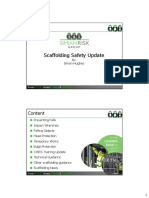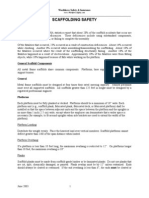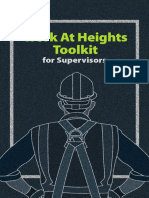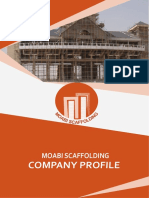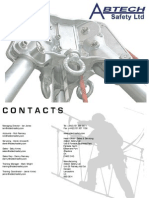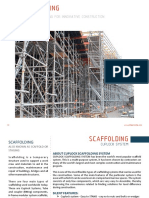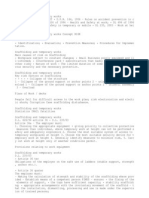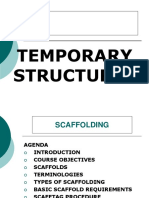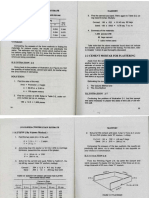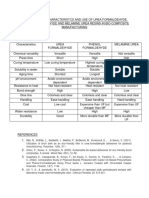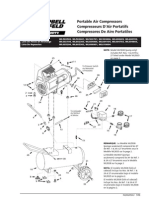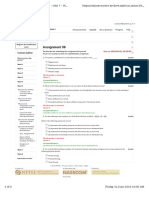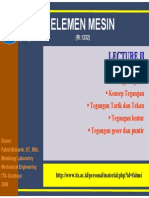100%(1)100% found this document useful (1 vote)
61 viewsSafe Scaffold1
Safe Scaffold1
Uploaded by
Anonymous 3VTQm3TgybWorking at heights poses serious safety risks. Scaffolds must be properly erected and inspected regularly by experienced workers. Scaffolds require secure foundations and framing, fully boarded working platforms with railings, and safe access such as secured ladders. Safety precautions are needed for all equipment used at heights such as ladders, steps and tubular access scaffolds. Proper inspection and use of quality materials is important to ensure scaffold safety.
Copyright:
© All Rights Reserved
Available Formats
Download as PPT, PDF, TXT or read online from Scribd
Safe Scaffold1
Safe Scaffold1
Uploaded by
Anonymous 3VTQm3Tgyb100%(1)100% found this document useful (1 vote)
61 views40 pagesWorking at heights poses serious safety risks. Scaffolds must be properly erected and inspected regularly by experienced workers. Scaffolds require secure foundations and framing, fully boarded working platforms with railings, and safe access such as secured ladders. Safety precautions are needed for all equipment used at heights such as ladders, steps and tubular access scaffolds. Proper inspection and use of quality materials is important to ensure scaffold safety.
Original Description:
working at height
Copyright
© © All Rights Reserved
Available Formats
PPT, PDF, TXT or read online from Scribd
Share this document
Did you find this document useful?
Is this content inappropriate?
Working at heights poses serious safety risks. Scaffolds must be properly erected and inspected regularly by experienced workers. Scaffolds require secure foundations and framing, fully boarded working platforms with railings, and safe access such as secured ladders. Safety precautions are needed for all equipment used at heights such as ladders, steps and tubular access scaffolds. Proper inspection and use of quality materials is important to ensure scaffold safety.
Copyright:
© All Rights Reserved
Available Formats
Download as PPT, PDF, TXT or read online from Scribd
Download as ppt, pdf, or txt
100%(1)100% found this document useful (1 vote)
61 views40 pagesSafe Scaffold1
Safe Scaffold1
Uploaded by
Anonymous 3VTQm3TgybWorking at heights poses serious safety risks. Scaffolds must be properly erected and inspected regularly by experienced workers. Scaffolds require secure foundations and framing, fully boarded working platforms with railings, and safe access such as secured ladders. Safety precautions are needed for all equipment used at heights such as ladders, steps and tubular access scaffolds. Proper inspection and use of quality materials is important to ensure scaffold safety.
Copyright:
© All Rights Reserved
Available Formats
Download as PPT, PDF, TXT or read online from Scribd
Download as ppt, pdf, or txt
You are on page 1of 40
WORKING AT HEIGHTS
SAFE SCAFFOLD WORKING
General: Working at
height is the largest single
cause of serious accidents
in the construction
industry and therefore all
appropriate measures to be
taken to ensure that
whenever workers are
working at a height,from
which they can fall
,suitable safety
precautions have been
taken.
USE OF SCAFFOLDS
All scaffolds shall be
erected and dismantled by
workmen who are
thoroughly experienced in
erection and dismantling
of scaffolding.
All scaffolds shall be
inspected on regular basis.
All scaffolds shall be
constructed of sound
materials free from patent
defects.
The following measures shall also be taken:
The scaffold shall be constructed for the correct
use(Light or Heavy duty)
Securely fixed to existing structures or adequately
buttressed;
The use of barrels,boxes,loose tiles or other
unsuitable material shall not be used as supports
for working platforms;
All working platforms shall be fully boarded;
All working platforms shall have guard rails at one
meter height and shall also have an intermediate
rail at half height.
All working platforms shall be kept free of
unnecessary obstruction or rubbish.
Secure ladder access shall be provided.
LADDERS,STEPS&TRESTLES
Ladders,steps&trestles are in common use
throughout the construction industry.Most
tradesmen need to use ladders or steps in their
work-either working from a ladder or using it to
gain access to the workplace.Probably because
ladders are familiar and widely used,they are often
neglected and misused.The fact that almost
anybody can obtain and set up a ladder of a pair of
steps (and may do so a number of time in the
working day)makes it no less important that it
should be done safely and properly.
The injuries suffered in falling from a
ladder,even from height of only a few feet
can be quite serious and may result in
permanent disability.It is very important that
the equipment should be sound and fit for
the job;and that the correct procedures are
followed in erecting and using it.
TYPES OF LADDERS
The main types of ladder are:
Standing ladders:-Single section ladder of up to
7.300m(24ft).The rungs may be rectangular or
round.
Pole Ladders:-Single section ladder but with the
stiles made from a whitewood pole cut down in
the middle.This ensures strength and
flexibility.Used mainly as an access ladder for
scaffolding.
Extension Ladders:-Have two or three sections
coupled together which extended by sliding over
or inside each other and secured by a latch.The
ladder may be extended by means of a rope and
pulley.
Roof Ladders:-Designed for use on
pitched(sloping)roofs,these ladders have a hook at
the top end for securing over the ridge of the roof.
Step Ladders:-Are free standing(i.e.they do not
have to be erected against wall,etc.)and have flat
rectangular treads which gives a secure
footing.they are mainly used to reach walls and
ceiling-especially for the purpose of fixing.
Aluminium Ladders:-Most types of ladder are
available in aluminium,e.g.steps,roofs
ladders,extension ladders,etc.They are lighter to
carry than timber ladders,are strong and will not
warp,but should not be used near electrical
equipment or an electrical supply because of
possibility of electric shock.
LADDERWAYS
(Fixed rungs or loops to
masts etc.)
Look for damaged welds.
Look for missing rungs
Report any problems to your
supervisor.Get repairs made
urgently.
Wear a safety belt or harness
when work has to be done
from any ladder way.
SCAFFOLDING
The main reason for erecting a scaffold is to
support working platform.Most construction work
involves working at heights which cannot be
easily or safely reached from the ground or part of
the building,therefore a scaffold is usually the
most convenient way of gaining access.
Scaffold may only be erected,altered or dismantled
under the supervision of a competent person or
experienced scaffolder.Scaffold must be rigid,built
of sound materials on good foundations and if
required,be well secured to the building or
structure.In public places,scaffolds must be well lit
or have warning lights fitted to the base.
Warning notices must be displayed on incomplete
scaffolds and precaution taken to ensure that no
unauthorised person can gain access to the
scaffold at any time.
INDEPENDENT SCAFFOLDS:-
As its name implies ,the independent scaffold is
“independent” of the building or structure.It has
two rows of parallel standards ,so that it is self-
supporting,although dependant on its
height,location and use ,it may be ‘tied’ to the
building or structure to give additional stability.
MATERIALS
All scaffolding materials must be inspected by an
experienced and competent person before use,any
unsound and unserviceable material should be
clearly marked and removed from site.
Materials used to build a scaffold must be in good
condition:the ends preferably bound and not
split,warped or twisted.Scaffold boards should not
be painted or treated in any way to conceal
defects.Other materials ,ropes,gin
wheels,ladders,etc.must all be in sound,serviceable
condition.
FOUNDATIONS:
Every scaffold structure must be “well
founded”.The foundation must be capable
of carrying the imposed load for the entire
life of the scaffold.On hard surface such as
steel or concrete of sufficient strength and
thickness,standards may be placed directly
on the surface.On other surfaces,base plates
and sole boards must be used to spread the
load.the ground beneath the sole plate must
be level and properly compacted.
THE SCAFFOLD FRAME:
The frame work of the scaffold is built from
metal tubes of varying lengths,joined
together with a variety of couplers or
clips(commonly called fittings).The actual
design and shape of the structure will
depend on the intended purpose of the
scaffold and the load it might be expected to
bear.However,there are certain basic
principles that are common to all types of
scaffold.
Safety Checklist
Base
Line of standards and ledgers
Line and spacing of transoms
Diagonal bracing(in both
directions)
Ties
Security of boards,toe boards and
guardrails.Maximum gap at wall
Security and correct use of couplers
and fittings.
Condition of tubes and fittings
Even spread of load on platform.
Means of access
Overloading
Security of stacked materials
TUBULAR ACCESS
SCAFFOLDS.
STANDARDS
Standards are the vertical elements of the scaffold
framework and as such carry the entire weight of the
structure and its load.Standards must be vertical,or lean
slightly towards the building.
The spacing of standards is determined by the intended use
of the scaffold,the distance between the standards being
reduced as the expected load increases.
The width of the working platform is also determined by
the purpose for which the scaffold is intended.This is
usually expressed in terms of ‘the number of boards wide’.
Joints in standards should be staggered :that is joints
should not occur at the same level in adjacent
standards.joints may be made with spigots,but if they are
likely to be subjected to tension,they should be
strengthened with lapped tubes,or sleeve couples should be
used.
LEDGERS:Ledgers are the main horizontal tubes
and provide lateral support to the structure.They
must be level,and fixed to the inside of the
standards with right angle,load-bearing couplers.
Ledgers should be joined with sleeve couplers,as
close to the node points(the points at which the
ledger is fixed to the standard) as possible :and
never more than one third of the bay distance from
a standard.All joints must be staggered.
A kicker lift or foot tie is normally used only on
heavy duty or long term scaffolds ,or where there
is a possibility that a standard could be displaced
by something striking it.
TRANSOMS
Main transoms are fixed ,either directly across to every
pair of standards,using right angle couplers,or laid across
and fixed to ledgers with putlog couplers(single fitting).In
this case,transoms should be fixed within 300 mm of
standards.Main transoms hold the two rows of standards in
position and are an integral of the structure.they must not
be removed unless expert advice is sought.
If the lift is to be boarded out as a working
platform,intermediate transoms will be required to support
the boards.These are fixed across ledgers with putlog
couplers,normally in the centre of each bay although
additional intermediate transoms may be required to
support short boards.
BRACES:
A scaffold must be braced in both directions,ledgers(or
cross bracing) must be fixed to (or adjacent to) alternate
pairs of standards along the entire length of the scaffold
and on each lift ,to the full height of the scaffold.
Face (or sway bracing) should be fixed along the face of
the scaffold ,either in zig-zag(or dog leg)fashion or as one
continuous sloping tube.It must be connected at the base
and every lift to extended transoms with right angle
couplers,or to every standard with swivel couplers.There
should be one such brace assembly along the face of the
scaffold every 30mts.or less.All joints in a continuous
brace must be made with a sleeve coupler or spliced with
lapped tube.
All braces form an integral part of the scaffold structure
and must not be removed without expert advice.
TIES:
To ensure that the scaffold framework cannot
move away from,or towards the building or
structure it must be stabilised.This is normally
achieved by securing the scaffold framework to
the structure with positive two-way ties.
Ties must not be removed except by an
experienced and competent scaffolder ,who must
ensure that the stability of the scaffold is not
jeopardised.They must be checked at regular
intervals to make sure they are secure.
WORKING PLATFORMS:
As previously stated the main purpose of scaffold is to
support a working platform.It is a requirement that such
working platforms should be suitable for the type of work
,provide security for the operative and secure that safety of
other-people passing below or near the scaffold.
If the platform is more than 2 mts.above the ground,it must
be close boarded and be fitted with guard rails and toe
boards.The guard rail should be set at height of 1mtr.above
the platform and the toe board be at least 150mm
high.Where materials are stocked above toe board height,a
suitable barrier(such as brick guards) must be erected to
prevent materials falling off.
Care should be taken to see that a working
platform and its scaffold are not
overloaded.Materials should be distributed as
evenly as possible with heavy items placed as near
to the standards as possible.
A working platform must be provided with a safe
and proper means of access.This is usually some
form of ladder,which must be firmly fixed and
extend above the level of the platform by a
minimum of five rungs(1mtr.)unless other
adequate hand-holds are provided.Landings
should be fitted with guard rails and toe boards
and should be kept clear.
INSPECTION
Every scaffold should be inspected by an
experienced and competent person,at least
once every seven days;after any substantial
alteration or adaptation and after storms or
bad weather conditions.A record of the
inspection must be kept.
SYSTEM SCAFFOLDS
System scaffolds are governed by the same
rules and regulation as previously stated.It
is important that manufacturers
recommendations are followed and that
different systems are not mixed on the same
scaffold.
SCAFFOLD TOWERS AND
MOBILE TOWERS
Scaffold towers may be constructed from
basic scaffold components or may be
specially designed ‘proprietary’ towers
made from lightweight alloys.They may be
mobile-fitted with wheels or castors for
easy movement-or static towers not
intended to be moved.
MOBILE SCAFFOLD
The stability of a tower depends very much
on the size of the base in relation to its
height :
Stationary internal tower 4:1
Stationary external tower 3.5:1
Mobile internal tower 3.5:1
Mobile external tower 3:1
The recommended maximum height for
mobile towers is 9.60m except that this may
be increased to 12m if it is tied to a
structure.
A static access tower should not be exceed a
maximum of 12m free standing.Above this
height the tower should be tied or be
specially designed to ensure stability by
means of ground anchors,guys or kentledge.
Working platforms must be close
boarded,hand rails and toeboards should
fitted. A ladder for access can be lashed
vertically to one of the narrow sides.
WHEN IN USE
Mobile towers should only be used on ground
which is firm and level.
Moving the structure should only be done by
pulling or pushing at the base.
Working platforms should be clear of men and
heavy materials when the scaffold is being moved.
Wheels should be turned outwards to provide
maximum base dimensions and wheel brakes must
be ‘on’ and locked when the scaffold is in use.
You might also like
- Kwikstage Scaffolding Plan and Method StatementDocument9 pagesKwikstage Scaffolding Plan and Method StatementDarren O HanlonNo ratings yet
- PIP PNE00003 (2019) - Process Unit and Offsites Layout GuideDocument23 pagesPIP PNE00003 (2019) - Process Unit and Offsites Layout GuideRichard Gutierrez100% (2)
- Scaff TrainingDocument29 pagesScaff TrainingrakeshNo ratings yet
- LLM - EH - STD - 1210 - 00.00 (00) - Safe Work Method StatementDocument5 pagesLLM - EH - STD - 1210 - 00.00 (00) - Safe Work Method StatementMatthew Mohan PerumalNo ratings yet
- RA Tower 0004 Dec 2011Document8 pagesRA Tower 0004 Dec 2011grandeNo ratings yet
- Scaffolding SafetyDocument4 pagesScaffolding Safetyrguy3223No ratings yet
- GL 17 ScaffoldingDocument18 pagesGL 17 Scaffoldingtp101267No ratings yet
- ScaffoldingDocument38 pagesScaffoldingCheNieAmir90% (21)
- Scaffolding Safety Instruction (498 A)Document5 pagesScaffolding Safety Instruction (498 A)Mythri Metallizing Pvt Ltd ProjectsNo ratings yet
- Rescue Plan: Hot Oil Drain DrumDocument3 pagesRescue Plan: Hot Oil Drain DrumNaveed AhmedNo ratings yet
- Edge Protection Manual With ApprovalDocument12 pagesEdge Protection Manual With ApprovalClaudioKAD100% (1)
- Fall Protection EngDocument1 pageFall Protection EngsrdrhsrcNo ratings yet
- Working at Heights: Engr. Jobelle B MalaygayDocument50 pagesWorking at Heights: Engr. Jobelle B MalaygayJohn Cedrik Retardo100% (1)
- Alu DeckDocument20 pagesAlu DeckYasserMohsen100% (1)
- WAH ToolkitDocument74 pagesWAH ToolkitKhuda BukshNo ratings yet
- WSH Guidelines - Landscape and Horticulture ManagementDocument35 pagesWSH Guidelines - Landscape and Horticulture Managementlwin_oo2435No ratings yet
- Scaffolding Safety: Erection of Mobile ScaffoldingDocument18 pagesScaffolding Safety: Erection of Mobile Scaffoldingmuzica muzNo ratings yet
- Duty of Care Act: Occupational Health and Safety Act 1984Document24 pagesDuty of Care Act: Occupational Health and Safety Act 1984Hoanghon BacNo ratings yet
- Scaffold Inspection Report 1Document2 pagesScaffold Inspection Report 1ronachaif3191No ratings yet
- Product Brochure - 2016-2017 - CompressedDocument24 pagesProduct Brochure - 2016-2017 - CompressedDeepu RavikumarNo ratings yet
- Edge Protection Concrete Structures-Brochure-DownloadDocument48 pagesEdge Protection Concrete Structures-Brochure-DownloadMrs MigginsNo ratings yet
- 1st Aid Training Siemens ContractorDocument11 pages1st Aid Training Siemens ContractorTigor GurningNo ratings yet
- K LockDocument16 pagesK LockA JoshiNo ratings yet
- En AuV Allround-2018Document60 pagesEn AuV Allround-2018ArdamitNo ratings yet
- Fallarrest Catalogue, CosmoPetra, CMCODocument30 pagesFallarrest Catalogue, CosmoPetra, CMCOSafe Lifting Solutions50% (2)
- 1-Construction Personal Protective Equipment (PPE) CatalogDocument92 pages1-Construction Personal Protective Equipment (PPE) CatalogMohamed AdelNo ratings yet
- Osh 3200Document245 pagesOsh 3200Chun Yip LauNo ratings yet
- Moabi Scaffolding Company ProfileDocument14 pagesMoabi Scaffolding Company ProfileISRAR SHAHNo ratings yet
- New Scaffold TagsDocument36 pagesNew Scaffold TagsPaolo AzurinNo ratings yet
- What Is ScaffoldDocument47 pagesWhat Is Scaffoldkolli.99995891No ratings yet
- Gen ScaffoldingsafetyDocument43 pagesGen ScaffoldingsafetyvhlactaotaoNo ratings yet
- Scaffolds: OSHA Office of Training & Education 1Document34 pagesScaffolds: OSHA Office of Training & Education 1khaan1830No ratings yet
- Construction - Scaffold Checklist - HSEDocument6 pagesConstruction - Scaffold Checklist - HSEtarek_bouzayaniNo ratings yet
- 3M Fall Protection Regional Catalogue 2017 FULL en WEB4 19.04.17Document71 pages3M Fall Protection Regional Catalogue 2017 FULL en WEB4 19.04.17George Lapusneanu100% (1)
- TRADStair User GuideDocument36 pagesTRADStair User GuideMark JeavensNo ratings yet
- Osha3722 PDFDocument2 pagesOsha3722 PDFTharaka Perera100% (1)
- Slide ScaffoldOverviewDocument32 pagesSlide ScaffoldOverviewVijayakumarVageesanNo ratings yet
- CG3 18 ProgrammesDocument2 pagesCG3 18 ProgrammesArdamitNo ratings yet
- Scaffold TrainingDocument34 pagesScaffold TraininggilNo ratings yet
- Scaffold User Safety: FN000681/CR/01Document51 pagesScaffold User Safety: FN000681/CR/01Ryan Au YongNo ratings yet
- Abtech Safety 2010 EmailDocument32 pagesAbtech Safety 2010 EmailpnsanatNo ratings yet
- Excavation Safety Precautions Trenching and Excavation Safety GuidelinesDocument6 pagesExcavation Safety Precautions Trenching and Excavation Safety GuidelinesJonathanNo ratings yet
- Woodlands N5C23 - FPP-TPWDocument29 pagesWoodlands N5C23 - FPP-TPWSuresh ThevanNo ratings yet
- Frame Scaffold Erection GuideDocument2 pagesFrame Scaffold Erection Guideputra2azanNo ratings yet
- Working at Heights: Dr.P.MuralidharDocument48 pagesWorking at Heights: Dr.P.MuralidharRituraj SinghNo ratings yet
- LLM - EH - STD - 1209 - 00.00 (00) - Environmental Management PlanDocument35 pagesLLM - EH - STD - 1209 - 00.00 (00) - Environmental Management PlanMatthew Mohan PerumalNo ratings yet
- CPCCPB3026 PresentationDocument85 pagesCPCCPB3026 PresentationAbdul Haseeb100% (1)
- ABB Scaffold Competent TestDocument4 pagesABB Scaffold Competent Testvasucristal100% (2)
- Method Statement ST100Document6 pagesMethod Statement ST100tarekNo ratings yet
- Fall ProtectionDocument105 pagesFall ProtectionvhlactaotaoNo ratings yet
- 2011 Dbi-Sala CatalogDocument77 pages2011 Dbi-Sala CatalogNelsongs52No ratings yet
- Company Profile 2024 Rev1Document32 pagesCompany Profile 2024 Rev1R ArcegaNo ratings yet
- Scaffolding: Smart Scaffolding For Innovative ConstructionDocument5 pagesScaffolding: Smart Scaffolding For Innovative ConstructionEbrahimAbuZaidNo ratings yet
- Scaffolding CourseDocument6 pagesScaffolding Course4gen_5No ratings yet
- The Handbook of Safety Engineering: Principles and ApplicationsFrom EverandThe Handbook of Safety Engineering: Principles and ApplicationsRating: 4 out of 5 stars4/5 (1)
- ScaffoldingDocument4 pagesScaffoldingolvernejacobs9741No ratings yet
- 6 Temporary StructuresDocument54 pages6 Temporary Structuresvox busmente100% (1)
- Scaffolding: Submittedby, Akhilesh. A Productionoperator (TR), Forbesbu MiarmadalimitedDocument42 pagesScaffolding: Submittedby, Akhilesh. A Productionoperator (TR), Forbesbu MiarmadalimitedChandan Kumar Singh100% (1)
- Erect Modular Sacffold NotesDocument16 pagesErect Modular Sacffold NotesAfifi YusoffNo ratings yet
- Scaff and Mewp and HeightDocument24 pagesScaff and Mewp and HeightRmr ReyesNo ratings yet
- Work at Height and "Scaffolding": WWW - Trivediassociates.co - inDocument22 pagesWork at Height and "Scaffolding": WWW - Trivediassociates.co - inReaz UddinNo ratings yet
- PlasteringDocument3 pagesPlasteringHerwinn Ruiz ReyesNo ratings yet
- PC130-7 SPC 10-09-2012Document352 pagesPC130-7 SPC 10-09-2012Plr. BaswapurNo ratings yet
- DoP Ref 0756-CPD-0322 Soudafix VE380-SF ENDocument3 pagesDoP Ref 0756-CPD-0322 Soudafix VE380-SF ENPranshu JainNo ratings yet
- EA9395Document4 pagesEA9395lacsmm982No ratings yet
- Comparison of Characteristcs and Use of Urea Formaldehyde, Phenol Formaldehyde and Melamine UreaDocument2 pagesComparison of Characteristcs and Use of Urea Formaldehyde, Phenol Formaldehyde and Melamine UreaAniq SyauqiNo ratings yet
- Beams and Other Flexural Members PDFDocument52 pagesBeams and Other Flexural Members PDFJeyjay BarnuevoNo ratings yet
- CNC Machine Img - 20230403 - 0005Document32 pagesCNC Machine Img - 20230403 - 0005abrahamNo ratings yet
- VRV Testing Check SheetDocument2 pagesVRV Testing Check SheetJahangir Hassan100% (1)
- REODATA40Document76 pagesREODATA40chanakaNo ratings yet
- SIRe Advance Quick GuideDocument25 pagesSIRe Advance Quick GuideJasperken2xNo ratings yet
- Campbell Haushfield Compressor Parts ListDocument3 pagesCampbell Haushfield Compressor Parts ListAnonymous rKtpSR3No ratings yet
- Orthodontic Wires - Properties / Orthodontic Courses by Indian Dental AcademyDocument226 pagesOrthodontic Wires - Properties / Orthodontic Courses by Indian Dental Academyindian dental academy100% (1)
- Final Report, NarayanganjDocument125 pagesFinal Report, NarayanganjNaim ParvejNo ratings yet
- Deep FoundationsDocument23 pagesDeep FoundationsMushaid Ali SyedNo ratings yet
- Unit 7 - Week 6: Assignment 06Document3 pagesUnit 7 - Week 6: Assignment 06SaurabhNo ratings yet
- Organization of American States General Secretariat Secretariat For Administration and Finance Office of General ServicesDocument23 pagesOrganization of American States General Secretariat Secretariat For Administration and Finance Office of General ServicesthirumalNo ratings yet
- 3.1-Pile Design Calculation For Boundary (p1 To p50)Document24 pages3.1-Pile Design Calculation For Boundary (p1 To p50)layaljamal2No ratings yet
- LG 35 40Document117 pagesLG 35 40tariku kirosNo ratings yet
- 40rr 72dpiDocument8 pages40rr 72dpiRONELNo ratings yet
- Handbook of Practical Smithing and ForgingDocument314 pagesHandbook of Practical Smithing and ForgingArtisan Ideas100% (2)
- 4.0 Anchoring Systems (128-389) r021Document265 pages4.0 Anchoring Systems (128-389) r021Anonymous SWOmOE8No ratings yet
- First Floor Revised Demarkation PlanDocument1 pageFirst Floor Revised Demarkation Planshubhamthakral56No ratings yet
- Tegangan Geser, Lengkung Dan PuntirDocument16 pagesTegangan Geser, Lengkung Dan PuntirAji ZanettiNo ratings yet
- 01-B - Centrifugal PumpsDocument44 pages01-B - Centrifugal Pumps81q1iyNo ratings yet
- Flint KoteDocument3 pagesFlint KoteDhim131267No ratings yet
- Influence of Semi-Rigidity of Joints On The Behaviour of Timber StructuresDocument11 pagesInfluence of Semi-Rigidity of Joints On The Behaviour of Timber StructuresnevinkoshyNo ratings yet
- National CAD Standards-SymbolsDocument136 pagesNational CAD Standards-SymbolsVania Natalie50% (2)
- Akhbar AlDar Oct - Dec #37 V7 20&21Document2 pagesAkhbar AlDar Oct - Dec #37 V7 20&21Abdulkareem TawiliNo ratings yet
- Set - 4Document8 pagesSet - 4Game LoveNo ratings yet


